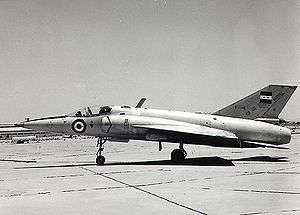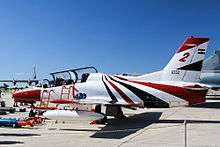Arab Organization for Industrialization
The Arab Organization for Industrialization (AOI) (Arabic: الهيئة العربية للتصنيع) is an Egypt-based Arab military organization established in 1975 by Egypt, The Kingdom of Saudi Arabia, The United Arab Emirates (UAE) and Qatar state to supervise the collective development of the Arab defense industry. Following a gradual deterioration in relations between the AOI member-states, Egypt became sole owner of AOI in 1993. As well as meeting the requirements of the Egyptian military, AOI directs spare capacity to civilian programmes, including civilian transport and sanitation equipment; additionally, AOI has stated its intention of entering the wind power sector.[2]
| Abbreviation | AOI |
|---|---|
| Formation | 1975 |
| Type | State-owned company |
| Purpose | Defence industry |
| Location |
|
Region served | Arab world |
Membership | Egypt Qatar (until 1993) Saudi Arabia (until 1993) United Arab Emirates |
Official language | Arabic |
Chairman | Abd El Aziz Seif-Eldeen |
Main organ | Supreme Committee |
Staff | ~16,000[1] |
| Website | www.aoi.org.eg |
Initially an institution of Pan-Arabism, Saudi Arabia and the United Arab Emirates returned their shares in AOI, valued at US$1.8 billion, to Egypt in 1993, leaving AOI wholly owned by Egypt. AOI has approximately 16,000 employees,[1] out of which 1,250 are engineers. AOI fully owns 12 factories and shares in 1 joint-ventures, besides the Arab Institute for Development Technology.
History
| Part of a series on | ||||||||
| Arab League | ||||||||
|---|---|---|---|---|---|---|---|---|
 | ||||||||
|
Issues
|
||||||||
|
||||||||
|
Governance
|
||||||||
|
||||||||
|
||||||||
|
||||||||
|
|
||||||||
|
||||||||
|
Culture
|
||||||||
AOI was established by its four member-states - Egypt, Qatar, Saudi Arabia and the UAE - in response to the threat posed by the advanced Israeli defence industry.[3] The initial capitalisation of AOI was USD 1 billion, contributed in equal part by the four member-states, although with the understanding AOI would be based in Egypt.[4]
Westland Helicopters v. Arab Organisation for Industrialization
In 1978, AOI and Westland Helicopters, a British aerospace company, established the Arab British Helicopter Company as a joint venture, but a year later AOI announced the company's liquidation. In ensuing arbitration, the International Chamber of Commerce made an award, on grounds of breach of the principles of natural law and good faith, in favour of Westland Helicopters and against AOI's four member-states.[5] This award was later annulled by the Court of Justice of Geneva,[6] which annulment was upheld by the Swiss Federal Supreme Court, on grounds that the arbitrators had jurisdiction over AOI but not over the organisation's member-states.[7][8]
Egyptian isolation
Following the signing of the Egypt-Israeli peace treaty (1979), Egypt had its membership to the Arab League suspended and a policy of economic isolation implemented against it. It was in this atmosphere that the three AOI member-states other than Egypt - Qatar, Saudi Arabia and the UAE - withdrew from the AOI, causing its collapse.[3]
In 1983, the Egyptian chief-of-staff restated his interest in the joint manufacture of weapons, but it was only after the 1987 Arab League summit in Amman, Jordan, when the Arab League re-admitted Egypt and the other Arab states normalised relations with Egypt, that the possibility of renewed co-operation among the AOI member-states seemed possible.[9]
The UAE seemed similarly eager to reinvigorate the AOI:[10] in 1988, Egypt and the UAE held talks with Qatar about its re-entry into the AOI, at which an agreement for closer co-operation between Egypt and Qatar in the fields of culture and communication was signed.[11]
Organization
AOI is one of the largest industrial organisations in Egypt[1] with significant international relationships both in the defence and civilian transport sectors.[1] The AOI is wholly state-owned by Egypt and administered by a Supreme Committee, the chairman of which is the Egyptian president and which includes several cabinet ministers,[1] but it is not a division of the Ministry of Military Production as the treaty upon which it was established declares the Arab Organization for Industrialization as an independent international Organisation, even though it is now only owned by Egypt but the establishing treaty stays the same, and changing it requires the consent of the establishing parties .[12]
Current enterprises
All AOI enterprises are ISO 9000/2001 and ISO 14001/2004 certified.[13]
AOI Aircraft Factory

The AOI's Aircraft Factory (Arabic: مصنع الطائرات, abbreviated ACF) was established in 1950 as Helwan Aircraft Factory and is a key aerospace manufacturer in Egypt.[14] It is located in Helwan.[15]
The AOI Aircraft Factory manufactures and assembles aircraft for the Egyptian air force, including:
- Helwan HA-200 Al Kahirah subsonic trainer
- Prototype Helwan HA-300 supersonic fighter
- Alpha Jet
- Tucano turboprop trainer
- the K-8E jet trainer.[14]
The K-8E is an Egyptian variant of the Chinese Hongdu JL-8, exported as the Karakorum-8 (or K-8) to (among others) Pakistan, Zambia and Myanmar. The K-8E's manufacture at the AOI Aircraft Factory began in 2000, under an agreement between the AOI and CATIC, the Chinese state-owned aerospace manufacturer, to produce a total of 60 K-8s over five years. The contract, valued at US$347.4 million, was signed in 1999 in connection with the state visit by Chinese president Jiang Zemin that year.[16] Initially, most of the parts were manufactured in China and the aircraft were assembled in Egypt, but by the end of the programme the manufacture was to be carried out entirely at the AOI Aircraft Factory. In the end, 98% of each K-8E was locally manufactured.[14]
The AOI Aircraft Factory also manufactures aircraft parts for the Egyptian Civil Aviation Authority (ECAA), Dassault Aviation and SAGEM, and has received certification from the ECAA for its welding, painting, testing and calibration operations.[14] The AOI Aircraft Factory also engages in civilian and technological projects.
AOI Engine Factory
In 1960, the Engine Factory (Arabic: مصنع المحركات) was established by the Egyptian military with German technical assistance as a base to design, develop and produce aircraft engines.[17] The first engines produced at the Engine Factory were:
- the E-200 for the Helwan HA-200 Al Kahirah subsonic trainer; and
- the E-300 for the Helwan HA-300 supersonic fighter.[17]
In 1975, the Engine Factory was affiliated to AOI, since when it has focused its activities on the manufacture, assembly, repair and overhaul of gas turbines and accessories. The AOI Engine Factory has established maintenance facilities for auxiliary power units and SNECMA Atar 09C, T56, CT64, PT6-25 and -64, Larzac 04, R-13 and R-25 engines.[17]
The AOI Engine Factory directs spare capacity to civilian projects, including the manufacture of fuel injectors for Robert Bosch GmbH, air brake systems for Knorr-Bremse and rail fastening clips for Pandrol.[17]
Major products
Compatible ordnance for BM-21 Grad, D-30 and M-46 Artillery systems, M60 Tanks, 85 mm divisional gun D-44, and ZSU-23-2 anti-aircraft guns.
M60 Tanks and M1A1 Abrams assembly from knock down kits
M60 and M1A1 Abrams engines and spare parts
Misr assault rifle and AK 47 complete manufacture (7,000 assault rifles a year), compatible ammunition
Major customers

- Egyptian Army
- Syrian Arab Army
- Iraqi Army
- Libyan National Army
- UAE Army
- Saudi Arabian National Guard
Other factories and enterprises
AOI Electronics Factory
Sakr Factory for Development Industries (AOI)
Kader Factory for Development Industries (AOI)
Arab British Engine Co. (ABECO) (AOI)
Arab British Dynamics Co. ABD (AOI)
Arab American Vehicle (AAV)
Egyptian Railways Equipment (SEMAF (ARE))
References
- "AOI in brief". Arab Organization for Industrialization. Arab Organization for Industrialization. Archived from the original (About us) on 2014-02-16. Retrieved 2010-08-06.
- "Future products". Arab Organization for Industrialization. Arab Organization for Industrialization. Retrieved 2010-08-06.
- German and Taylor 2004: 322
- Shidlo 1993: 241
- Westland Helicopters Ltd v. Arab Organization for Industrialization, United Arab Emirates, Kingdom of Saudi Arabia, State of Qatar, Arab Republic of Egypt and Arab British Helicopter Company, 80 ILR 600, 613 (1984-03-05).
- Arab Organization for Industrialization and others v. Westland Helicopters Ltd and others, 80 ILR 622 (1987-10-23).
- Arab Organization for Industrialization and others v. Westland Helicopters Ltd, 80 ILR 652 (Federal Supreme Court (First Civil Court) 1988-07-19).
- Klabbers 2002: 312
- German and Taylor 2004: 329
- Nolan 1992: 72
- Rabi 1990: 458
- Cordesman 2002: 65
- "International certifications, About us". Arab Organization for Industrialization. Arab Organization for Industrialization. Retrieved 2010-08-06.
- "About the factory". Arab Organization for Industrialization Aircraft Factory (in Arabic). Arab Organization for Industrialization.
- "Contact us". Arab Organization for Industrialization Aircraft Factory (in Arabic). Arab Organization for Industrialization.
- Xinhua (2005-08-30). "China award Egypt aircraft production licence". China Daily. Retrieved 2011-07-01.
- "History". Engine Factory. Arab Organization for Industrialization.
Bibliography
- Cordesman, Anthony H. (2002). Peace and war: the Arab-Israeli military balance enters the twenty-first century. Westport, Connecticut: Praeger Publishers. ISBN 978-0-275-96939-4.
- German, Richard; Taylor, Elizabeth (2004). "Egypt: economy". In Dean, Lucy (ed.). The Middle East and North Africa (50 ed.). London: Europa Publications. ISBN 978-1-85743-184-1.
- Klabbers, Jan (2002). An introduction to international institutional law. Cambridge: Cambridge University Press. ISBN 0-521-81774-9.
- Nolan, Janne E. (1992). "Worldwide threats and implications for the U.S. force structure: the Middle East and South Asia". Worldwide military threats: implications for U.S. forces.
- Rabi, Ubi (1990). "Qatar". In Ayalon, Ami; Shaked, Haim (eds.). Middle East contemporary survey. XII 1988. Boulder, Colorado: Westview Press, Inc. ISBN 978-0-8133-1044-2.
- Shidlo, Gil (1993). "Third World arms exports to Iraq before and after the Gulf War". In Barzilai, Gad; Klieman, Aharon; Shidlo, Gil (eds.). The Gulf crisis and its global aftermath. London: Routledge. ISBN 978-0-415-08002-6.